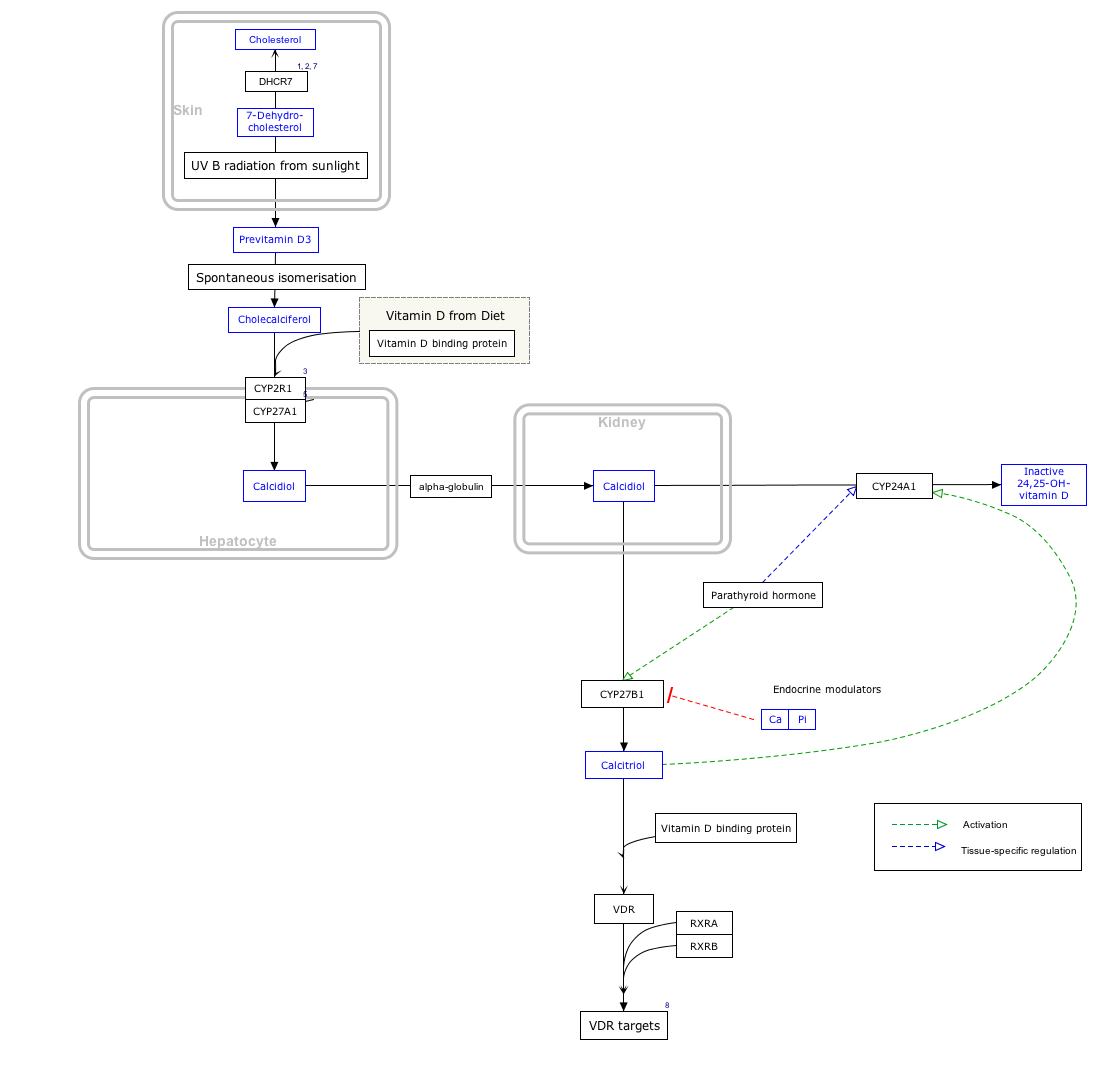Calcifediol/ja: Difference between revisions
Created page with "この検査はビタミンD欠乏症の診断に用いることができ、ビタミンD欠乏症のリスクが高い人に実施され、検査結果がビタミンDサプリメントによる補充療法開始の支持に用いられる。 骨粗鬆症、慢性腎臓病、吸収不良、肥満、その他の感染症の患者はビタミンD欠乏のリ..." Tags: Mobile edit Mobile web edit |
Created page with "==歴史{{Anchor|History}}== ヘクター・デルーカの研究室での研究は、1968年に25(OH)Dを同定し、その生成には肝臓が必要であることを示した。この合成を担う酵素であるコレカルシフェロール25-ヒドロキシラーゼは、1972年に同じ研究室でマイケル・F・ホリックによって単離された。" Tags: Mobile edit Mobile web edit |
||
| (6 intermediate revisions by the same user not shown) | |||
| Line 109: | Line 109: | ||
[[osteoporosis/ja|骨粗鬆症]]、[[chronic kidney disease/ja|慢性腎臓病]]、[[malabsorption/ja|吸収不良]]、[[obesity/ja|肥満]]、その他の感染症の患者はビタミンD欠乏のリスクが高いため、この検査を受ける可能性が高い。ビタミンD欠乏症は、緯度の高い地域に住んでいる人や日光浴が制限されている人など、一部の集団ではよくみられるが、25(OH)D検査は通常、全住民に対して要求されることはない。医師は、リスクの低い患者には、スクリーニング検査を受ける代わりに[[Over-the-counter drug/ja|市販の]]ビタミンDサプリメントを摂取するように勧めることがある。 | [[osteoporosis/ja|骨粗鬆症]]、[[chronic kidney disease/ja|慢性腎臓病]]、[[malabsorption/ja|吸収不良]]、[[obesity/ja|肥満]]、その他の感染症の患者はビタミンD欠乏のリスクが高いため、この検査を受ける可能性が高い。ビタミンD欠乏症は、緯度の高い地域に住んでいる人や日光浴が制限されている人など、一部の集団ではよくみられるが、25(OH)D検査は通常、全住民に対して要求されることはない。医師は、リスクの低い患者には、スクリーニング検査を受ける代わりに[[Over-the-counter drug/ja|市販の]]ビタミンDサプリメントを摂取するように勧めることがある。 | ||
25(OH)Dは最も[[sensitivity and specificity/ja|感度]]の指標であるが、専門家は異なる検査室間での標準化と再現性の改善を求めている。[[:en:MedlinePlus|MedlinePlus]]によると、25(OH)Dの推奨範囲は20~40 ng/mL(50~100 nmol/L)であるが、多くの専門家は30~50 ng/mL(75~125 nmol/L)を推奨していると認識している。正常範囲は、年齢や地域などいくつかの要因によって大きく異なる。また、20~150 nmol/L(8~60 ng/mL)という広範な[[reference ranges for blood tests/ja|基準範囲]]も示唆されているが、80 nmol/L(32 ng/mL)未満をビタミンD欠乏症と定義する研究もある。 | |||
カルシフェジオール濃度が80 nmol/L(32 ng/mL)まで上昇すると、腸から吸収されるカルシウムの割合が増加する。尿中カルシウム排泄は腸管カルシウム吸収のバランスをとり、カルシフェジオール濃度が~400 nmol/L(160 ng/mL)までは増加しない。 | |||
==サプリメント{{Anchor|Supplementation}}== | |||
==Supplementation== | ビタミンDの状態を改善するために、カルシフェジオールのサプリメントがいくつかの研究で使用されている。その適応には、ビタミンDの欠乏または不全、難治性くる病([[vitamin D resistant rickets/ja|ビタミンD抵抗性くる病]])、[[familial hypophosphatemia/ja|家族性低リン血症]]、[[hypoparathyroidism/ja|副甲状腺機能低下症]]、低カルシウム血症および[[renal osteodystrophy/ja|腎性骨異栄養症]]が含まれ、カルシウムとともに、原発性またはコルチコステロイド誘発性の[[osteoporosis/ja|骨粗鬆症]]に使用される。 | ||
ビタミンD欠乏症の改善には、カルシフェジオールがコレカルシフェロールよりも優れている可能性がある。両者の経口投与量を比較した9件の[[randomized control trials/ja|ランダム化比較試験]]の結果を検討したところ、カルシフェジオールはコレカルシフェロールの3.2倍の効力があることがわかった。 カルシフェジオールは腸からの吸収がよく、ビタミン-D結合蛋白に対する親和性が高いため、生物学的利用能が向上する。経口投与されたカルシフェジオールは半減期が非常に短く、排泄も早い。これらの特性は、腸[[malabsorption/ja|吸収不良]]、肥満、または他の特定の医薬品で治療を受けている人に有益であろう。 | |||
2016年、FDAは[[chronic kidney disease/ja|慢性腎臓病]]患者の二次性[[hyperparathyroidism/ja|副甲状腺機能亢進症]]を治療する処方医薬品として、カルシフェジオール(Rayaldee)1日60マイクログラムの製剤を承認した。 | |||
==インタラクティブ経路マップ== | |||
{{VitaminDSynthesis_WP1531|highlight=Calcifediol}} | {{VitaminDSynthesis_WP1531|highlight=Calcifediol}} | ||
==歴史{{Anchor|History}}== | |||
==History== | [[:en:Hector DeLuca|ヘクター・デルーカ]]の研究室での研究は、1968年に25(OH)Dを同定し、その生成には肝臓が必要であることを示した。この合成を担う酵素である[[cholecalciferol 25-hydroxylase/ja|コレカルシフェロール25-ヒドロキシラーゼ]]は、1972年に同じ研究室で[[:en:Michael F. Holick|マイケル・F・ホリック]]によって単離された。 | ||
==研究{{Anchor|Research}}== | ==研究{{Anchor|Research}}== | ||
Latest revision as of 21:05, 12 April 2024

| |

| |
| Names | |
|---|---|
| Preferred IUPAC name
(1S,3Z)-3-[(2E)-2-{(1R,3aS,7aR)-1-[(2R)-6-Hydroxy-6-methylheptan-2-yl]-7a-methyloctahydro-4H-inden-4-ylidene}ethylidene]-4-methylidenecyclohexan-1-ol | |
| Other names
25-Hydroxyvitamin D3
25-Hydroxycholecalciferol Calcidiol | |
| Identifiers | |
3D model (JSmol)
|
|
| ChEBI | |
| ChEMBL | |
| ChemSpider | |
| DrugBank | |
| KEGG | |
| MeSH | Calcifediol |
PubChem CID
|
|
| UNII | |
| |
| |
| Properties | |
| C27H44O2 | |
| Molar mass | 400.64 g/mol |
| Pharmacology | |
| H05BX05 (WHO) | |
カルシフェジオール(Calcifediol)は、カルシジオール、25-ヒドロキシコレカルシフェロール、または25-ヒドロキシビタミンD3(略称25(OH)D3)としても知られている、 は、ビタミンD3(コレカルシフェロール)が酵素ビタミンD 25-水酸化酵素によって肝臓で水酸化されることによって生成されるビタミンDの一種である。カルシフェジオールは酵素によってさらに水酸化される。主に腎臓に存在する25(OH)D-1α-ヒドロキシラーゼによってさらに水酸化され、活性型ビタミンDであるカルシトリオール(1,25-(OH)2D3)となる。
カルシフェジオールは血液中でビタミンD結合タンパク質と強く結合している。血清カルシフェジオールの測定は、ビタミンD欠乏または充足を示すために、人のビタミンDの状態を決定するために行われる通常の検査である。カルシフェジオールは、ビタミンDを補充する経口医薬品として一部の国で販売されている。
生化学
カルシフェジオールは、活性型ビタミンDであるカルシトリオールの前駆体であり、肝臓でコレカルシフェロール(ビタミンD3)の25位を水酸化することにより合成される。この酵素的な25位水酸化酵素反応は、ミクロソームに存在するCYP2R1の作用によるところが大きいが、ミトコンドリアCYP27A1などの他の酵素が寄与することもある。肥満における低レベルなど、CYP2R1の発現および活性の変動は、循環カルシフェジオールに影響を及ぼす。同様に、ビタミンD2であるエルゴカルシフェロールもまた、25-ヒドロキシル化されて25-ヒドロキシエルゴカルシフェロール(エルカルシジオール、25(OH)D2)を形成することができる;両方の形態は、血中では25(OH)Dとして一緒に測定される。
コレカルシフェロールの一般的な摂取量(最大2000IU/日)では、カルシフェジオールへの変換は急速である。 大量摂取(100,000IU)の場合、カルシフェジオール濃度がピークに達するまでに7日間かかる。 カルシフェジオールは血中ではビタミンD結合蛋白(gc-グロブリンとしても知られる)と結合し、主な循環ビタミンD代謝産物である。カルシフェジオールの消失半減期は約15~30日である。
カルシフェジオールは腎臓でさらに1α位で水酸化され、1,25-(OH)2D3、カルシトリオールを形成する。この酵素的25(OH)D-1α-ヒドロキシラーゼ反応はCYP27B1によってのみ行われ、腎臓では主に副甲状腺ホルモンによって制御されるが、FGF23やカルシトリオール自体によっても制御される。CYP27B1は、マクロファージ、単球、ケラチノサイト、胎盤および副甲状腺を含む他の多くの組織でも発現しており、カルシフェジオールからのカルシトリオールの腎外合成は、これらの組織において生物学的効果を有することが示されている。
カルシフェジオールはまた、24-水酸化によって24,25-ジヒドロキシコレカルシフェロールに変換される。この酵素反応はCYP24A1によって行われ、腎臓を含む多くのビタミンD標的組織に発現しており、カルシトリオールによって誘導される。これはカルシトリオールをカルシトロ酸に不活性化するが、24,25-(OH)2D3はそれ自体いくつかの生物学的作用を有する。
ビタミンD欠乏症の血液検査
医学検査では、25-ヒドロキシビタミンD(25(OH)D)の血液検査を行い、ビタミンDの状態を判定する。 25(OH)Dという名称は、ビタミンD3に由来するカルシフェジオール(25-ヒドロキシ-コレカルシフェロール)と、ビタミンD2に由来するエルカルシジオール(25-ヒドロキシ-エルゴカルシフェロール)の組み合わせを指す。 これらのうち最初のもの(25-ヒドロキシビタミンD3としても知られる)は、体内で作られるか、特定の動物性食品やコレカルシフェロールのサプリメントから摂取される。2つ目(25-ヒドロキシビタミンD2)は、特定の植物性食品やエルゴカルシフェロールのサプリメントから摂取される。
この測定値は、総合的なビタミンDの状態を示す最良の指標と考えられている。米国の検査機関では、一般的に25(OH)D値をng/mLで報告している。他の国ではnmol/Lを用いる。ng/mLに2.5をかけてnmol/Lに変換する。
この検査はビタミンD欠乏症の診断に用いることができ、ビタミンD欠乏症のリスクが高い人に実施され、検査結果がビタミンDサプリメントによる補充療法開始の支持に用いられる。 骨粗鬆症、慢性腎臓病、吸収不良、肥満、その他の感染症の患者はビタミンD欠乏のリスクが高いため、この検査を受ける可能性が高い。ビタミンD欠乏症は、緯度の高い地域に住んでいる人や日光浴が制限されている人など、一部の集団ではよくみられるが、25(OH)D検査は通常、全住民に対して要求されることはない。医師は、リスクの低い患者には、スクリーニング検査を受ける代わりに市販のビタミンDサプリメントを摂取するように勧めることがある。
25(OH)Dは最も感度の指標であるが、専門家は異なる検査室間での標準化と再現性の改善を求めている。MedlinePlusによると、25(OH)Dの推奨範囲は20~40 ng/mL(50~100 nmol/L)であるが、多くの専門家は30~50 ng/mL(75~125 nmol/L)を推奨していると認識している。正常範囲は、年齢や地域などいくつかの要因によって大きく異なる。また、20~150 nmol/L(8~60 ng/mL)という広範な基準範囲も示唆されているが、80 nmol/L(32 ng/mL)未満をビタミンD欠乏症と定義する研究もある。
カルシフェジオール濃度が80 nmol/L(32 ng/mL)まで上昇すると、腸から吸収されるカルシウムの割合が増加する。尿中カルシウム排泄は腸管カルシウム吸収のバランスをとり、カルシフェジオール濃度が~400 nmol/L(160 ng/mL)までは増加しない。
サプリメント
ビタミンDの状態を改善するために、カルシフェジオールのサプリメントがいくつかの研究で使用されている。その適応には、ビタミンDの欠乏または不全、難治性くる病(ビタミンD抵抗性くる病)、家族性低リン血症、副甲状腺機能低下症、低カルシウム血症および腎性骨異栄養症が含まれ、カルシウムとともに、原発性またはコルチコステロイド誘発性の骨粗鬆症に使用される。
ビタミンD欠乏症の改善には、カルシフェジオールがコレカルシフェロールよりも優れている可能性がある。両者の経口投与量を比較した9件のランダム化比較試験の結果を検討したところ、カルシフェジオールはコレカルシフェロールの3.2倍の効力があることがわかった。 カルシフェジオールは腸からの吸収がよく、ビタミン-D結合蛋白に対する親和性が高いため、生物学的利用能が向上する。経口投与されたカルシフェジオールは半減期が非常に短く、排泄も早い。これらの特性は、腸吸収不良、肥満、または他の特定の医薬品で治療を受けている人に有益であろう。
2016年、FDAは慢性腎臓病患者の二次性副甲状腺機能亢進症を治療する処方医薬品として、カルシフェジオール(Rayaldee)1日60マイクログラムの製剤を承認した。
インタラクティブ経路マップ
Click on genes, proteins and metabolites below to link to respective articles. [§ 1]
- ↑ The interactive pathway map can be edited at WikiPathways: "VitaminDSynthesis_WP1531".
歴史
ヘクター・デルーカの研究室での研究は、1968年に25(OH)Dを同定し、その生成には肝臓が必要であることを示した。この合成を担う酵素であるコレカルシフェロール25-ヒドロキシラーゼは、1972年に同じ研究室でマイケル・F・ホリックによって単離された。
研究
骨粗鬆症の予防と治療において、カルシフェジオールとコレカルシフェロールを含む他のビタミンDの効果を比較する研究が進行中である。
